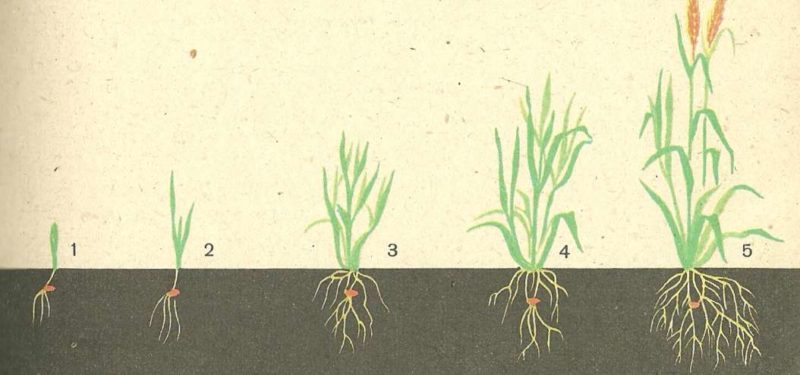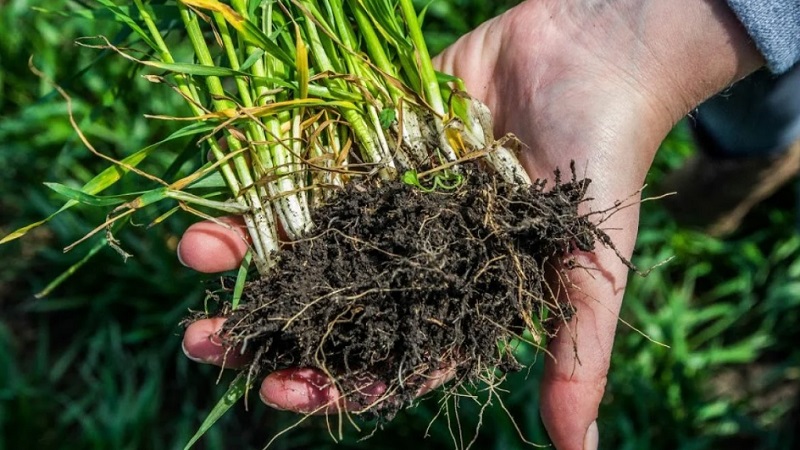What is the root system of wheat and what are its features
Wheat is a representative of the monocotyledonous class, the family of cereals. Its importance in the life and history of mankind can hardly be overestimated. This is the main raw material for flour and all types of bakery products. The plant is massively used as a technical or fodder crop.
The content of the article
Features of the wheat root system
Roots up to 2 m long nourish plants with the necessary elements, however, they do not absorb water over the entire surface. Moisture is absorbed by thin hairs covered with plant mucus. This area is called the suction zone. Nearby is the division zone - the part that is responsible for growth.
Interesting! Another feature of wheat roots is density: they occupy up to 300,000 km per hectare of sown soil.

Root type
Wheat, like all monocots, has a fibrous system.: instead of a pronounced main root, there is a cluster of lateral ones. This allows the crop to cover a large area, but the side roots do not go deep into the soil. In fact, the fibrous system is a development in breadth, not in depth.
The tillering node plays an important role in the development of the cereal root. - several underground stem nodes, close to each other. Under good conditions, several such knots are tied. They look like a thickening of the stem in the soil, at a depth of 1-3 cm. They are formed in the development phase of 3-4 leaves.
New shoots are formed from the node - its death or damage completely destroys the plant. Therefore, the preservation of this formation is one of the top priorities for agronomists when sowing.
A large number of shoots on one plant reduces efficiency of the resources absorbed by it, therefore, it is considered that in a cereal with 4-5 shoots the number of additional ears is optimally correlated with their quality. Additional shoots under such conditions do not differ from the main one in straw length, size and number of spikelets and grains.
Interesting on the site:
Use of wheat as green manure in autumn and spring
How the root grows and develops
When the pericarp bursts at the bottom of the grain, the main root appears... After 2-3 days, the first 2 lateral roots are formed, after another 1-2 days the second pair develops. Above them, the sixth and seventh are formed, which grow at right angles to the first 2 pairs.
Reference! Since these roots originate from the embryonic seed, they are called embryonic. They persist throughout the life of the cereal, although they occupy a relatively small part of the entire system.
At the beginning of development, 4 leaves on the embryonic stem at the level of 1 leaf begin to form tillering nodes with adventitious roots, which so far look like small papillae. As they grow, they break through the leaf from which they were laid, since they are close to each other.

What factors influence
Many factors affect the development and growth of roots.: fertilizers, soil temperature and moisture, soil structure and acidity, sowing time.
For the correct formation of the primary root system, soil temperature should be within + 15 ... + 20 ° С. Development will begin at lower rates, but then it will be slower. The tillering node is affected by the moisture of the earth: if the soil is dry, it will not receive enough nutrients.
The plant does not develop well in too acidic soil... Acidity negatively affects the suction zone, preventing the absorption of minerals.
Read also:
The role of fertilizers in root development
Soil rarely has enough nutrients in an easy-to-digest form... Therefore, wheat is additionally fertilized. An incorrect ratio of phosphorus, potassium and nitrogen reduces plant productivity and grain quality and increases vulnerability to disease.
The amount of minerals for the formation of a sufficient grain yield per 1 ha:
- 25–35 kg of nitrogen;
- 11-13 kg of phosphorus;
- 20-27 kg of potassium;
- 5 kg of calcium;
- 4 kg magnesium;
- 3.5 kg of sulfur;
- 5 g boron;
- 8.5 g of copper;
- 270 g of iron;
- 82 g of manganese;
- 60 g zinc;
- 0.7 g molybdenum.
Nitrogen fertilizers are applied in early spring... They accelerate tillering, increase the density of the stem and the number of segments of the spikelet. When the plant begins to grow into the tube, a second feeding is carried out, which increases the yield. The third time the wheat is fertilized when it is heading.

Secondary roots in winter wheat
Winter crops have primary roots, which are formed in the embryonic hypocotyl (embryonic stem) of seeds, and secondary, developing from tillering nodes. The latter appear 20 days after germination. During the tillering period, 2 roots are formed from each new stem, which feed the lateral shoots. At the same time, the primary roots do not stop their work, and if the secondary ones have not developed (for example, due to drought), then they completely provide the cereal with minerals and water.
Attention! Secondary roots are formed only at a sufficient level of humidity (60–70% of the total moisture capacity) and temperatures within + 10… + 24 ° С. They grow more intensively if the wheat has been sown 3-4 cm deep.
The absorbing activity of the secondary system is influenced by an element such as sulfur... The trace element participates in carbohydrate and nitrogen metabolism, ensures the accumulation of starch and sugar in the grain. With a lack of substance in the soil and roots, the yield of the crop decreases.
Sulfur content in the roots of winter wheat: 5: 1 in relation to nitrogen.
Conclusion
The root system of wheat is just as important for a rich harvest as the stem. It provides transport of water and nutrients, influencing the process of photosynthesis. Roots develop correctly at optimal humidity, temperature, soil composition.